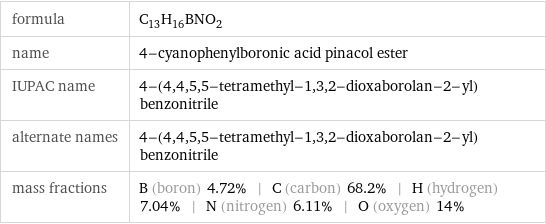Input interpretation

4-cyanophenylboronic acid pinacol ester
Chemical names and formulas

formula | C_13H_16BNO_2 name | 4-cyanophenylboronic acid pinacol ester IUPAC name | 4-(4, 4, 5, 5-tetramethyl-1, 3, 2-dioxaborolan-2-yl)benzonitrile alternate names | 4-(4, 4, 5, 5-tetramethyl-1, 3, 2-dioxaborolan-2-yl)benzonitrile mass fractions | B (boron) 4.72% | C (carbon) 68.2% | H (hydrogen) 7.04% | N (nitrogen) 6.11% | O (oxygen) 14%
Lewis structure

Draw the Lewis structure of 4-cyanophenylboronic acid pinacol ester. Start by drawing the overall structure of the molecule, ignoring potential double and triple bonds: Count the total valence electrons of the boron (n_B, val = 3), carbon (n_C, val = 4), hydrogen (n_H, val = 1), nitrogen (n_N, val = 5), and oxygen (n_O, val = 6) atoms: n_B, val + 13 n_C, val + 16 n_H, val + n_N, val + 2 n_O, val = 88 Calculate the number of electrons needed to completely fill the valence shells for boron (n_B, full = 6), carbon (n_C, full = 8), hydrogen (n_H, full = 2), nitrogen (n_N, full = 8), and oxygen (n_O, full = 8): n_B, full + 13 n_C, full + 16 n_H, full + n_N, full + 2 n_O, full = 166 Subtracting these two numbers shows that 166 - 88 = 78 bonding electrons are needed. Each bond has two electrons, so in addition to the 34 bonds already present in the diagram add 5 bonds. To minimize formal charge nitrogen wants 3 bonds and carbon wants 4 bonds. Identify the atoms that want additional bonds and the number of electrons remaining on each atom: Fill in the 5 bonds by pairing electrons between adjacent highlighted atoms. Note that the six atom ring is aromatic, so that the single and double bonds may be rearranged: Answer: | |
Basic properties

molar mass | 229.09 g/mol phase | solid (at STP) melting point | 97 °C
Units

Chemical identifiers

CAS number | 171364-82-2 PubChem CID number | 2734625 PubChem SID number | 24874625 SMILES identifier | B1(OC(C(O1)(C)C)(C)C)C2=CC=C(C=C2)C#N InChI identifier | InChI=1/C13H16BNO2/c1-12(2)13(3, 4)17-14(16-12)11-7-5-10(9-15)6-8-11/h5-8H, 1-4H3 MDL number | MFCD03093897